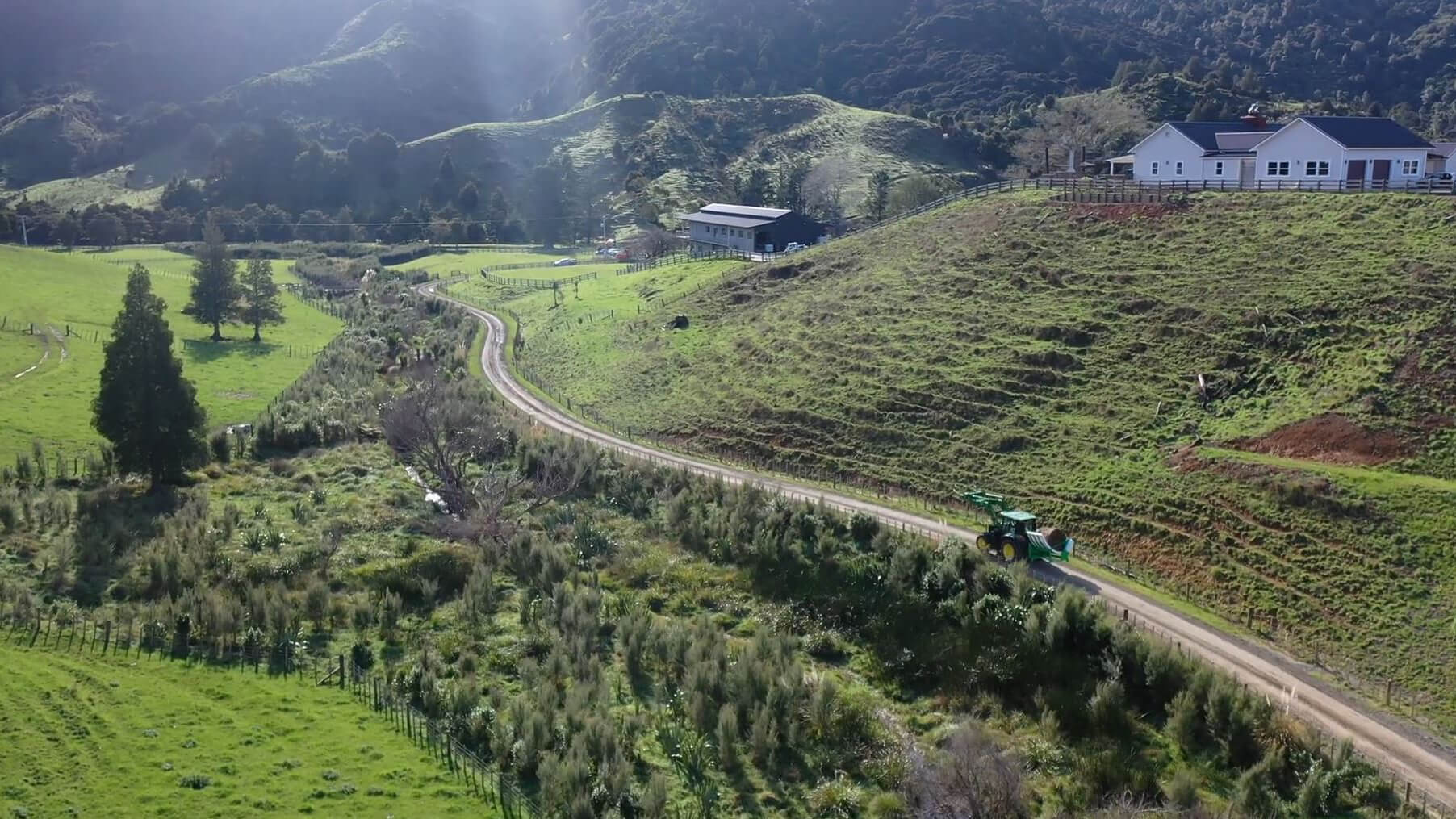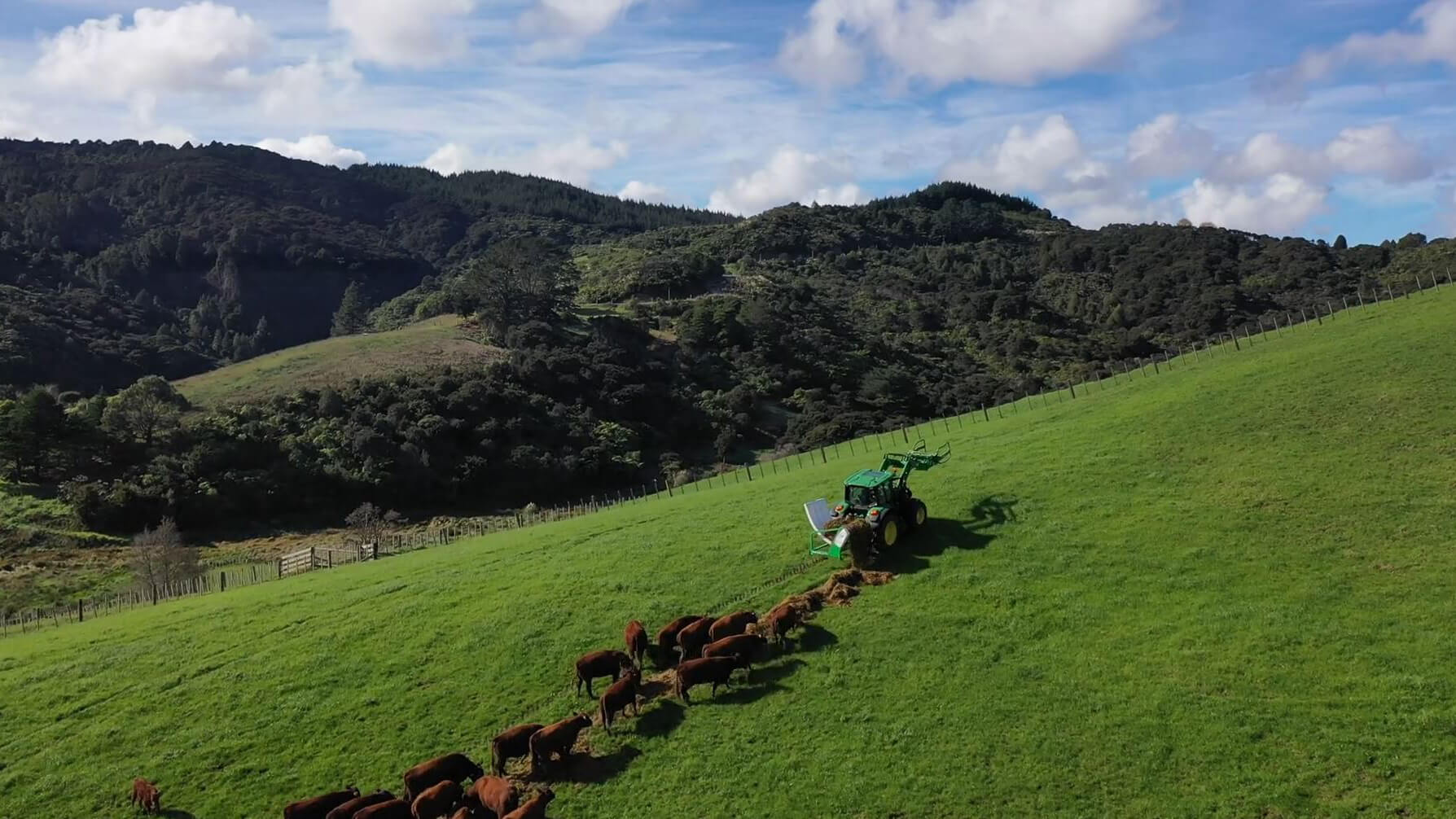New Zealand Farmers save 30% on hay with their Hustler Chainless Bale Feeder
Ian and Maggie Hutchinson breed pedigree Red Devon cattle on a 330-acre farm in Ahuroa, New Zealand. They started with a Hustler Softhands bale grab. They liked that well enough to then get a Chainless LX104 mounted bale feeder, and Ian says, “From Bale Number One, it was remarkably simple.” And about the hay savings, he says, “That was the first thing I noticed, the animals ate the entirety of it. So the cost of a bale price dropped 30% by just the method we were feeding out.” Watch the video below to see what Ian and Maggie have to say about their machine.
Ian and Maggie live on their farm at Ahuroa, one hour north of Auckland, New Zealand. They farm about 130 top-pedigree Red Devon cattle, an ancient breed from the southwestern English county of Devon – among the earliest breeds imported to New Zealand – on a 330-acre block.
The couple bought Maggie’s family estate back in 2016. The farm has been in Maggie’s family for four generations. At the time, the farm wasn’t in a very good state of repair and they have spent a lot of time and effort re-fencing, re-irrigating… with the ambition “to make sure to do things environmentally correctly”.
It has been a true challenge for them as both work outside the farm. Ian is a civil and structural consulting engineer with no farming background.
“The farming is in the spare time” meaning “that spare time is from 4 am to 7 am in the morning” or during the weekend, so the time spent on farm chores needs to be perfectly optimised which is why Ian and Maggie decided to invest in efficient tools to help them. “Maggie looks after the farm during the day and if there’s anything to be done at night time we both do that after work, so for us, the big thing is that it’s easy, efficient and safe,” Ian explained.

Feeding out the cattle herd represents a big chunk of time in Ian and Maggie’s busy schedule. “Originally when we fed out, it was a long and laborious process and I would use my little digger to put hay on the back of the trailer and feed out and after that became quite frustrating,” Ian told. Before this frustration, Ian and Maggie needed to change things to make it easier for them, especially in wintertime when they have to take care of the farm in the dark.
“We purchased a Hustler Softhands and that sped up the process remarkably”
“We did our research, I spoke to a lot of other farmers and we looked at Fieldays at different types and so we purchased a Hustler Softhands and that sped up the process remarkably,” Ian recalled. And because it is wise to stick with a winning formula, they’ve “had such a success with the Softhands, we settled on the Chainless bale feeder from Hustler,” Ian continued.
When the Hustler Chainless bale feeder arrived on the farm and it was time to use it for the first time Ian thought that it “could be a disaster” but realised soon enough “from bale Number One, it was remarkably simple.”
“We’ve had such a success with the Softhands, we settled on the Chainless bale feeder from Hustler”
As well as saving time with the new bale feeder, Ian and Maggie have also made significant savings on hay – and therefore money. They didn’t expect this and it has been a bonus!

Ian explained this is due to the way they are feeding out the hay. “When you’re feeding out in bulk or you’re just putting a bale on a pallet, there’s probably 30% wastage.” “That’s the first thing I noticed when we fed out [with the Hustler], there was nothing left in the paddock,” Ian exclaimed in amazement. As “the animals ate the entirety of [the hay], the cost of a bale price dropped 30%,” Ian added. According to him, “probably the thing that is the best and the easiest about the bale feeder is that there’s no wastage and when you’re feeding out the entirety of the bale is dispensed.”
“The cost of a bale price dropped 30% by just the method we’re feeding out”
After commenting on the ease of use of their machine and the savings made, Ian mentions a third advantage – the efficiency of the Hustler Chainless bale feeder. The Chainless range has been designed to handle any type of bales, rounds and squares, and its versatility is proven with both dry hay and wet silage.
“Some days you’ll get a nice dry one, other days you’ll get quite a wet silage one but they feed out equally as well”
Depending on your baling equipment or your hay contractor, and on plenty of other factors such as the storage conditions, the hay can be quite different from one bale to another. Ian and Maggie encounter this problem on their farm, with their own hay bales. “One of the things I also found was that bale moisture content varies a lot and some days you’ll get a nice dry one, other days you’ll get quite a wet silage one and I thought that might have given a problem but they feed out equally as well, so very simple to operate,” concluded Ian.
If you want to know a bit more about Ian and Maggie’s regenerative journey on their farm, listen to our #FeedGrassForGood podcast. We devoted an entire episode to the land and water restoration work they’ve done on their block. You can find our podcast on your favourite audio streaming platform, Apple Podcast, Google Podcast or Spotify.
And have a look at more testimonials from happy mounted Chainless bale feeders owners around the world:
- After 12 years of using a Chainless bale feeder, a New Zealand dairy farmer decided to stick with Hustler
- Canadian beef farmer finds affordable bale feeding solution to put more pounds on his herd with a 12% saving on hay
- Two French brothers love their Hustler Chainless bale feeder and here is why!
- Working Smarter, Not Harder is this American rancher’s goal
The top-of-the-range Chainless mounted bale processor feeds every type of square or round bale and has been proven on more bale types than any other bale feeder. It’s self-loading with integrated tynes and a patented, hands-free quick hitch system, that makes connecting the feeding cradle to the headstock quicker and easier. Downtime is eliminated with very low maintenance and no wear parts.

























